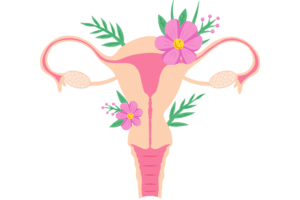
Normal Menstruation
Each month the endometrium, or lining of the uterus, builds up and sheds. This is called the menstrual cycle. The hormones estrogen and progesterone cause changes in the lining. An average menstrual cycle lasts about 28 days, counting from the first day of one period to the first day of the next. Bleeding normally lasts about 5-7 days.
Most women lose about ¼ cup of blood during their period, although it may seem like more. Some women have longer periods or heavier bleeding.
Heavy Bleeding
One in five women has heavy bleeding at some point during her childbearing years. Heavy bleeding is most common for women between ages 40 and 50, as they approach menopause. It also can be caused by hormonal changes or certain medical conditions, such as problems with blood clotting. Although there are other causes of heavy bleeding, such as growths, ablation is not used to treat these problems.
Losing too much blood can lead to anemia (lack of iron in blood). It also can affect your ability to do the things you need to do. In most cases, the doctor first tries to treat the bleeding with medication. If the bleeding can’t be controlled, ablation may be used.
About Ablation
Ablation destroys a thin layer of the lining of the uterus. This stops all menstrual flow in many women. After ablation, some women still have light bleeding or spotting. A few women may have regular periods. This is because the ovaries and uterus are not removed. If ablation does not control heavy bleeding, further treatment or surgery may be required.
Most women are not able to get pregnant after ablation. Thus, if you may want to become pregnant, you should not have endometrial ablation. Although pregnancy is not likely after ablation, you should keep using some form of birth control until after menopause. You also may want to think about sterilization as an option to prevent pregnancy. Ablation does not affect sexual response.
A woman who has had ablation still has all her reproductive organs in place. Because of this, routine Pap tests and pelvis exams are still needed after ablation.
Before the Procedure
You will talk with your doctor and have a number of tests before the procedure is done. The tests may include: hysteroscopy, a slender, light-transmitting telescope, the hysteroscope, is used to view the inside of the uterus; ultrasound, sound waves are used to view the pelvis organs; or endometrial biopsy, a small amount of the tissue lining the uterus is removed and viewed under a microscope.
A few weeks or months before the procedure, your doctor may prescribe medication that will help thin the lining of your uterus. This will help expose the cell layer that needs to be removed.
Side effects of the medication include vaginal dryness, hot flashes, and night sweats. The effects will go away once the medication is out of your system.
The Procedure
Ablation is a short procedure. It is done as outpatient surgery in most cases. This means you can go home the same day.
You most likely will be given some form of pain relief or sedative to help you relax before the procedure. The type of pain relief used depends on the type of ablation procedure, where it is done, and your wishes. Discuss this with your doctor.
There are no incisions (cuts) involved in ablation. Recovery takes about 2 hours, depending on the type of pain relief used.
Your doctor will use one of a number of types of energy to burn away the uterine lining. These may include electrical, laser (light), or thermal (heat) ablation. As new techniques emerge, your doctor can explain them.
Electrical
A loop or rollerball tool can be used to destroy the thin inner lining of the uterus. For the procedure, the walls of the cervix are widened to allow passage of a device called a hysteroscope. The doctor looks through it to see the inside of your uterus on a monitor. Your uterus is filled with fluid to expand it. Then, the ball or loop is pulled across the endometrial surface. The rollerball or loop applies an electric current to the surface as it is pulled across the lining. This current destroys the lining.
Laser
A laser device burns the lining using a high-intensity light beam. Like the rollerball and loop, the laser reaches the lining of the uterus though the hysteroscope. The laser then destroys the lining of the uterus.
Thermal
With thermal ablation, a device or fluid is inserted into your uterus, heat and energy are applied to increase the temperature and destroy the lining.
Risks
There is some risk involved with many procedures. Most problems result from pain medication, blood loss, or infection.
The ablation procedure has certain risks. The device used may pass through the uterine wall or bowel. Rarely, the fluid used to expand your uterus may be absorbed into your bloodstream. This may allow too much fluid in your body and can be serious.
After the Procedure
Some minor side effects are common after endometrial ablation:
- Cramping, like menstrual cramps, for 1-2 days
- Small amount of thin, watery discharge mixed with blood, which can last a few weeks
- Frequent urination for 24 hours
- Nausea
Ask your doctor about when you can exercise, have sex, or use tampons. In most cases, you can expect to go back to work or to your normal activities within a day or two.
You doctor will arrange follow-up visits to check your progress. It may take a few months to achieve result.
***THIS INFORMATION COMES FROM THE ENDOMETRIAL ABLATION BROCHURE PRODUCED BY THE AMERICAN COLLEGE OF OBSTETRICIANS AND GYNECOLOGISTS©. ***
